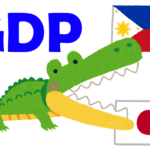
Yesterday, the yen hit 150 yen to the dollar, the first time in 32 years since 1990.
It was April of this year when I lamented the fact that the yen was now 126 to the dollar. In just six months since then, it has depreciated another 24 yen, or 19% at a rate of 19%.
The yen also depreciated against the Philippine peso, with 10,000 pesos now worth 25,490 yen. Since the peso has also depreciated against the dollar, the yen has fallen only 5.1%. Nevertheless, the 10,000 peso appreciated by 1,240 yen, which is painful for those who send money home.
The dollar has risen in value against other currencies, but most against the yen.
Many reports cite the difference in interest rates between the U.S. and Japan as the reason, but this does not seem to be the only reason. This is because the currencies of the U.K., the EU, and the Philippines, which are raising interest rates in the same way as the U.S., are also losing value across the board.
Although the Ministry of Finance has said that it will not hesitate to intervene in foreign exchange markets if speculation is involved, I believe that there is a growing trend for individuals to convert yen into dollars to buy dollars and U.S. stocks, in addition to actual demand to procure dollars in response to rising energy and food prices.
Prime Minister Kishida has been actively promoting the "doubling of asset income through investment," but Japanese stocks have been stagnant for a long time, and financial assets do not increase by investing in Japanese stocks. Therefore, it is natural for him to invest in growing U.S. stocks to increase his financial assets. In other words, PM Kishida's asset-income doubling plan is like asking people to sell the yen and buy dollars.
A weaker yen has both advantages and disadvantages. Import prices will rise, so you will have to pay more than before when procuring food and energy resources from overseas. On the other hand, when exporting, there is the benefit that exports will increase because Japanese-made goods will become more price-competitive because the other country can purchase them at lower prices. This advantage is the reason why the so-called currency depreciation is called a policy of impoverishing the neighborhood.
Japan was once known as the world's factory. At that time, the benefits of a weaker yen were great, but many companies have already moved their factories overseas, and the disadvantages are becoming more noticeable than the benefits.
In September, exports totaled 8,818.6 billion yen and imports 10,912.6 billion yen, resulting in a trade balance deficit of 2,939.9 billion yen.
On my personal level, this is a disadvantage with regard to sending money to the Philippines. On the other hand, the average purchase price of a dollar deposit is 108 yen, so at 150 yen to the dollar, this would mean a 38.9% increase in assets.
Given the economic situation in Japan and the U.S., it is generally believed that the yen will continue to weaken for the time being. 160 yen per dollar is likely to be the next target, after which the yen may swing higher.
Therefore, I am planning to sell my dollar holdings when the yen reaches 160 yen.









